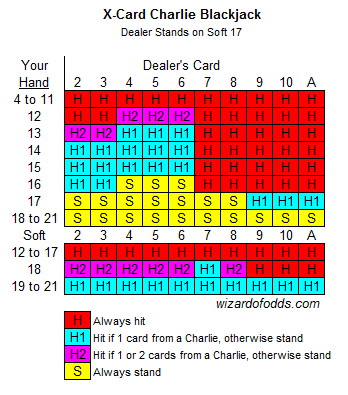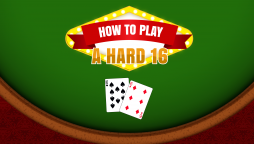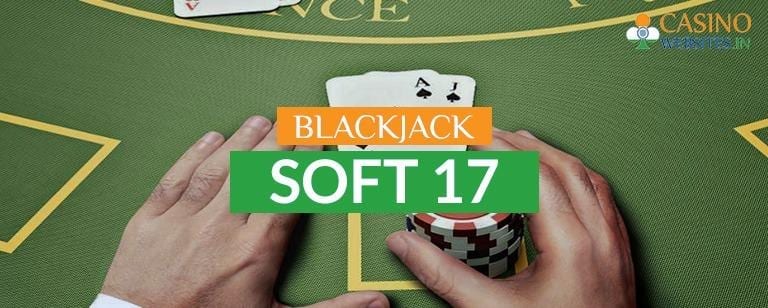Blackjack Hard Vs Soft 17


Blackjack Appendix 9 — Six deck, dealer stands on soft 17, no hole card. Blackjack Appendix 9 — Six deck, dealer hits on soft 17, no hole card. Blackjack Appendix 9 — Five decks, dealer stands on soft 17, no hole card. Blackjack Appendix 9 — Five decks, dealer hits on soft 17, no hole card. Provided that the dealer hits soft 17, it is also recommended to surrender hard 15 against an ace. You should forfeit paired 7s against the dealer’s 10 in single-deck S17 blackjack. If one deck is in play and the dealer must hit soft 17, surrendering is advisable against tens and aces when you have 7-7. For example, the combination of an Ace and a six is called the soft 17. Likewise, a pair consisting of an Ace and a seven is called the soft 18, and so on. On the other hand, a pair of cards without an Ace counted as 11 is called a hard hand. So, the combinations of 10+7 or 7+9+A are all examples of hard hands in blackjack. Enter any Blackjack Soft 17 Vs Hard 17 casino, and the biggest bets are always on the baccarat tables. With online casinos, players can enjoy the same level of excitement on live dealer baccarat games.
For those who are just starting out to learn to play and love blackjack, some of the slang used through the game might sound weird or even funny at times, like for instance “soft and hard hands”. These are the types of hands you could get from the dealer in any given play, let’s understand how they behave in the game:

The difference between a “hard” and “soft” hand in blackjack is one single card. The Ace. If one of the two cards you’re dealt is an Ace, you have a “soft” hand. Why? An Ace card can either be a 1 or an 11 which means that you have quite a bit of liquidity as far as what you can play based on the card the dealer holds.
If you have an Ace and an 8, your hand could either be 9 or 19. If you have an Ace and a 4, your hand could either be a 5 or a 15. With an Ace the risk is less which is why it’s considered “soft.” A “hard” hand in blackjack means that you don’t have an Ace. With a “hard” hand you are stuck with a rigid hand that cannot be changed. If you are dealt two 5s you have 10. If you’re dealt a 10 and a Queen you have 20. So on and so forth…
It really is interesting to see how one single card can make such a big difference. Want to try your hand at blackjack? Check out the great table games available on Palace of Chance.
The terms ‘hard’ and ‘soft’ in blackjack refer to whether or not a hand features a flexible Ace. If it doesn’t, the hand is hard; if it does, the hand is soft. New players might not see the significance of such a distinction. An 18 is an 18 and should be played the same way regardless of the specific cards involved, right?
Wrong. Whether a total is soft or hard can have a big impact on correct blackjack strategy, especially when playing with liberal rules for doubling down. Furthermore, the dealer’s treatment of flexible scores is pivotal when it comes to calculating the house edge.
Hard totals in Australian blackjack
A hard total is one with no Ace, or where the Ace can only count as one point without busting (e.g. A 6 8 = hard 15). There are 18 possible hard values in a standard blackjack game, starting at four points and finishing at 21.
With the exception of splittable pairs, the basic strategy for hard hands in Australian casino blackjack is rather straightforward:
| Dealer card | ||||||||||
|---|---|---|---|---|---|---|---|---|---|---|
| Player hand | 2 | 3 | 4 | 5 | 6 | 7 | 8 | 9 | 10 | A |
| 5-8 | H | H | H | H | H | H | H | H | H | H |
| 9 | H | D | D | D | D | H | H | H | H | H |
| 10 | D | D | D | D | D | D | D | D | H | H |
| 11 | D | D | D | D | D | D | D | D | H | H |
| 12 | H | H | S | S | S | H | H | H | H | H |
| 13-16 | S | S | S | S | S | H | H | H | H | H |
| 17-21 | S | S | S | S | S | S | S | S | S | S |
Green (H) = Hit
Red (S) = Stand
Orange (D) = Double down (if not allowed, hit)
Blackjack Soft 17
How to play soft hands in 21
A soft total features an Ace (or Aces) that can count as either one point or 11. For example: an Ace and an Eight is called a soft 19 because it can be either 19 points or nine. There are nine valid soft scores in blackjack, the lowest of which is 13 (A 2).
The proper play for soft hands can vary significantly depending on certain rules. Most Australian blackjack games don’t allow players to double down on soft totals, for instance, while US casinos tend to allow doubling on any two cards. As shown below, according to an eight-deck game where the dealer always stands on 17, the Aussie restrictions make for a much simpler strategy while Vegas rules allow players to be quite aggressive with a soft 17 or lower.
Double down on hard nine, 10, or 11 only:
| Dealer card | ||||||||||
|---|---|---|---|---|---|---|---|---|---|---|
| Player hand | 2 | 3 | 4 | 5 | 6 | 7 | 8 | 9 | 10 | A |
| 13-17 | H | H | H | H | H | H | H | H | H | H |
| 18 | S | S | S | S | S | S | S | H | H | H |
| 19-21 | S | S | S | S | S | S | S | S | S | S |
Double down on any two cards:
| Dealer card | ||||||||||
|---|---|---|---|---|---|---|---|---|---|---|
| Player hand | 2 | 3 | 4 | 5 | 6 | 7 | 8 | 9 | 10 | A |
| 13-14 | H | H | H | Dh | Dh | H | H | H | H | H |
| 15-16 | H | H | Dh | Dh | Dh | H | H | H | H | H |
| 17 | H | Dh | Dh | Dh | Dh | H | H | H | H | H |
| 18 | S | Ds | Ds | Ds | Ds | S | S | H | H | H |
| 19-21 | S | S | S | S | S | S | S | S | S | S |
Blackjack Hard Vs Soft 17 Against
Green (H) = Hit
Red (S) = Stand
Orange (Dh) = Double down (if not allowed, hit)
Pink (Ds) = Double down (if not allowed, stand)
Dealer hits soft 17 rule
There once was a time when the house always stood pat with 17, regardless of whether or not the hand featured a two-way Ace. Nowadays, however, many land-based casinos instruct their blackjack dealers to hit on soft 17, which has a considerable impact on the odds.
In a regular shoe game with six to eight decks in play, the dealer hitting on 17 adds about 0.22% to the house edge. That’s greater than the overall margin on some online blackjack games, such as Microgaming’s Classic Blackjack Gold Series (0.13% with basic strategy).
In Vegas-style 21, this rule also affects the ideal strategy for doubling down. For example: when the dealer stands on soft 17, most experts would advise against doubling on 11 when the house shows an Ace; but when the dealer hits on soft 17, such a move would be encouraged.